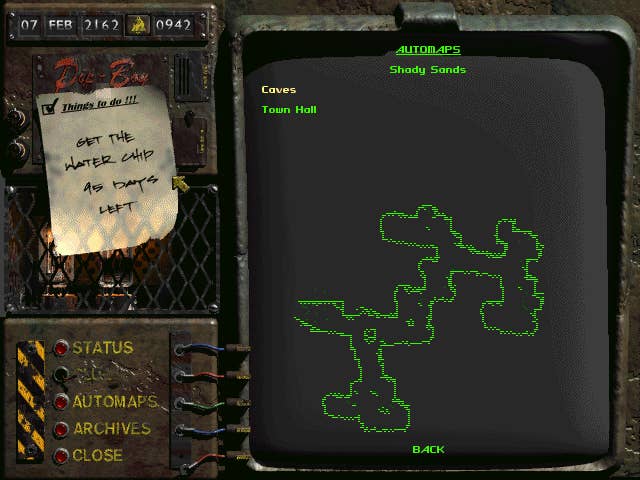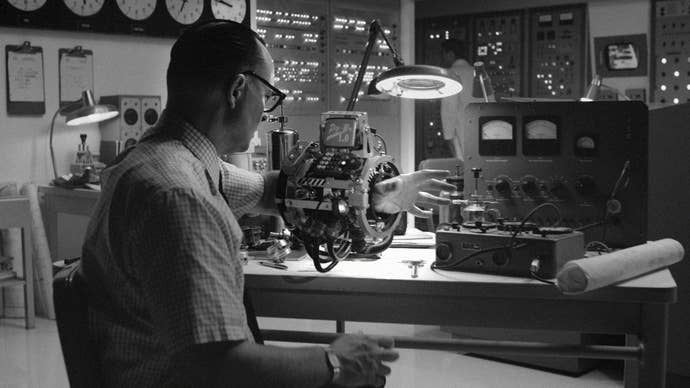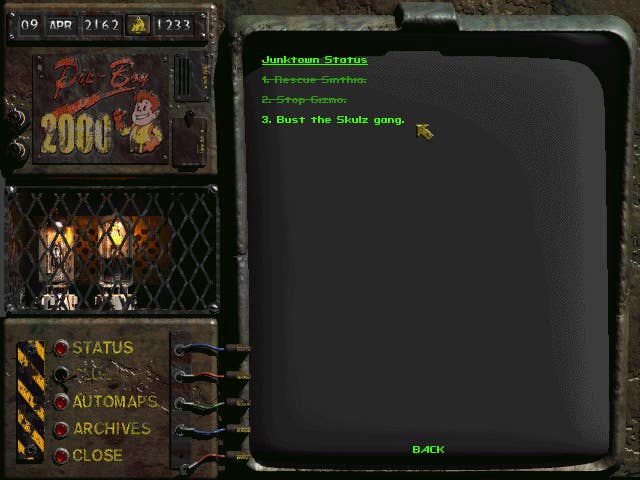Behind the Creation and Evolution of Fallout's Iconic Pip-Boy
With insight from designers, what Fallout's iconic device tells us about its ever-changing post-apocalyptic wasteland.
This article first appeared on USgamer, a partner publication of VG247. Some content, such as this article, has been migrated to VG247 for posterity after USgamer's closure - but it has not been edited or further vetted by the VG247 team.
Before Bethesda Softworks’ visually immaculate Fallout universe, there were the grainy snapshots of Interplay Entertainment's portrayal of a landscape desecrated by the ashes of a nuclear fallout. As the original entry of this post-apocalyptic series, it was Interplay’s Fallout that introduced the prototypical Pip-Boy to the world—the device that’s now so synonymous with the Fallout name itself. This version is vastly different from the streamlined, wrist-mounted devices by Bethesda; instead, it’s a clunky assemblage of rusted metal, vacuum tubes, and wire meshes meant to be held by hand and prodded at like a tablet.
Despite numerous facelifts, the Pip-Boy remains one of the most iconic tools in video game history, thanks to the series’ popularity and the tool’s ubiquity. And as it's evolved from a rusty handheld device to a chunky watch, the gadget’s transformation is also emblematic of the series’ divergence. What started as a top-down, turn-based RPG is now more akin to a first-person shooter today. The older Pip-Boy is said to have more superfluous functions—including screensavers, buddy chat programs and alarms—even though these aren’t accessible features in the game, whereas the newer devices are more concerned with expanding on their stylistic flourishes and visual language. In fact, the Pip-Boy has only become even more diegetic with the Bethesda era of Fallout, with the interface becoming an in-universe device that characters can stare at from a first-person perspective.
So what else could be inferred about the Pip-Boy and its universe? Are these iterations true to the retrofuturism trend and Fallout’s old world kitsch? And are they functionally designed for a grueling universe where everything has gone up in flames? Armed with this burning curiosity, I decided to ask two people who can offer some insights: Leonard Boyarsky, one of the lead designers of Fallout at Interplay, who’s now at Obsidian Entertainment; and Liz (pseudonym), an award-winning industrial designer with her own multi-disciplinary design studio.

The Classic Pip-Boy
As a design trend, one of the most notable showcases of retrofuturism is a collaboration between General Motors and Norman Bel Geddes, a prominent industrial designer back in the ‘30s. Titled Futurama, it was an exhibit into a possible model of the world 20 years into the future, featuring cutting-edge technology and streamlined designs, including automated highways and the prevalence of automotive vehicles. These also happen to be some of the most recognizable traits of Fallout, and is what guides the series’ distinctive style.
“Retrofuturism is often characterized by depictions of technology in a nostalgic style,” Liz shared. “Its juxtaposition of the past and the future—the idea of taking something familiar and displacing it in time—is what makes the trend so impactful in evoking powerfully hypothetical experiences in people's minds.” As with the exhibition, she added that the creations of Bel Geddes and other notable industrial designers also gave rise to a design movement known as Streamline Moderne, an aesthetic that’s marked by smooth curves and horizontal lines. “These characteristics definitely became part of today’s retrofuturistic vocabulary.”
But these traits are more evident in Bethesda’s contoured Pip-Boy designs. In contrast, the classic Pip-Boy is much more angular and blocky. According to Boyarsky, this disparity is mostly due to how the original design is heavily skewed towards his personal preference rather than any adherence to specific trends. “I just really like the look of old, clunky technology,” he said. “To be honest, I don’t remember if we came up with the ‘50s theme—it was [close to] 25 years ago—but if we did, we may have streamlined [the Pip-Boy] a little bit more.”
The Pip-Boy’s bulkiness also served a secondary purpose: it’s symbolic of an irreparable world torn apart by war and conflict.
“This was also just my way of creating a feeling that the world wasn’t quite working, like you can see the seams [of this universe],” Boyarsky said. “Whereas if you had sleek technology, it will feel very functional, or to be without problems. I wanted our stuff to feel like maybe it wasn’t all that dependable, like it’s kind of hacked together to a certain degree.”
This heftiness also points towards how the gadget is probably constructed for use mostly within the walls of the vault—a point that Liz was also quick to latch onto. She was skeptical about the device’s portability, and the likelihood of the Pip-Boy to accommodate additional screens and extensions. Tellingly, a footnote from the Vault Dweller Survival Guide—the manual included with the original Fallout—stated that Pip-Boys were issued with a brief three-month limited warranty; these aren’t hardy devices that can withstand the rigors of time.
Aside from personal taste, Boyarsky also wanted the user interface to resemble an in-world object, one that looked like it was plucked from the Fallout universe itself. Such interfaces weren’t the norm at the time of Fallout’s development in 1997; instead, many video games featured two-dimensional interfaces that seemed explicitly removed from their fiction.
Wanting the Pip-Boy to have an appearance that’s more three-dimensional and tactile than most other interfaces at that time, Boyarsky tapped on the industrial design expertise of another Interplay designer—Anthony Postma—who eventually came up with the device’s layout. “I knew what I wanted in terms of the way the Pip-Boy feels, but I’m not, in any way, performing as an industrial designer; I was mostly trained as an illustrator,” said Boyarsky.

The Modern Pip-Boy
Since acquiring the rights to the Fallout IP in 2004, Bethesda has significantly ramped up the series’ retrofuturism themes. Not only does its old-world furniture carry the Streamline Moderne qualities—the curved forms, long lines—mentioned earlier, this aesthetic is also reflected in the newer Pip-Boy models that look sleeker and much more polished than the original one. Despite these changes, Liz thought these devices still looked relatively bulky, perhaps even too unwieldy to use in the wilderness. “I wonder if I would have an overdeveloped left arm from wearing the Pip-Boy all the time!” she remarked. ”Would people eventually evolve their bodies to counterbalance [the weight of] this device, since it’s key to their survival?” She also pointed out how the retro flair of the Pip-Boy 3000 Mark IV (the model in Fallout 4) differs slightly from retrofuturism convention. In fact, the screen is reminiscent of the CRT computer monitors of the 1980s, like that of green phosphor screens.
Meanwhile, Boyarsky has been impressed by the flourishes of Bethesda’s Pip-Boy designs, but mentioned that he would have loved to see some embellishments from the original design—the exposed wires, vacuum tubes, and speakers—in the later models.
“Because they had to make it fit on your arm, they lost a bit of those little touches,” he mused. He even brought up how the mascot he had originally designed for the Pip-Boy, which was prominently displayed on the classic device, was missing in these iterations (for the record, this is different from the Vault Boy, who has somehow become the de facto mascot of modern Fallout). “I don’t know why they don’t want to put the Pip-Boy logo on the [newer] Pip-Boy anymore... I’m hurt, really!” he laughed, his voice carrying a slight note of dismay.
That’s why he was glad to see these elements return in Fallout 76’s Pip-Boy; in fact, the aforementioned mascot makes a comeback too, but with a small, albeit unintentional tweak. “For some reason, everyone draws him with pointed ears! There was a restriction or a problem with the technology at that time, so everyone thought he had pointed ears because of how pixelated it was,” said Boyarsky. Some minute but significant details also drew his attention. In particular, the ridges on the roof of the newer Pip-Boy was one feature Postma had included in his original sketches, which was faithfully executed throughout every screen interface in Fallout 1 and 2.

More Than a Watch
Given that electronic components will only become increasingly scarce in the Fallout timeline, Liz imagined that future Pip-Boys would probably be cobbled together from scavenged components, or even discarded Pip-Boy devices. “Seeing how future iterations of the Pip-Boy will need to be repaired and hacked together from old parts would be interesting.”
Liz also brought up the probability of vault dwellers modifying and hacking their Pip-Boy. As it’s capable of storing crucial information and even intimate data, the Pip-Boy is an incredibly personal device. So why haven’t vault dwellers attempted to personalize this tool? And with various cliques and gangs from the vault—like the boorish Tunnel Snakes from Fallout 3—seeing how some individuals and factions would customize their Pip-Boy as a form of personal expression and group identity would be fascinating, particularly in a multiplayer setting like Fallout 76.
“I would love to see variations of Pip-Boys based on these different factions,” she wondered. “How would each group modify their Pip-Boys based on their modus operandi? Would some have more weaponized features? Could there be rare finds to upgrade your Pip-Boy [with]?” While it’s doubtful that such features will be implemented in Fallout 76, there may be other means for factions to differentiate themselves with.
The limits placed on graphical fidelity back in the late ‘90s may have been an obstacle for more ambitious designers. That’s why I wanted to ask Boyarsky if he would make any changes to Interplay’s Pip-Boy design today, especially with the vastly superior graphical capabilities afforded by modern technology. Yet, he sounded almost surprised by my question, and after some pause, responded with a no. It was the graphical constraints of the past that gave the Pip-Boy’s its trademark grimy look, he explained, which accentuates the dated, deteriorating appearance he envisioned the device to have.

“Our biggest problem at that time was that we didn’t have the detailed resolution to get some of the finer details. We did have a restriction of 240 colours, but we also used that to our advantage,” said Boyarsky. “I tried to use that pixelation to make things look worn and dirty. Because of where we were at technology-wise, we wanted to use these constraints to help, as opposed to hinder, what we were trying to do.” In his own words, the device had already “conveyed the feeling of the world” to its fullest extent.
This thoughtful labor behind the iconic Pip-Boy is probably what makes the device so memorable; like the twisted amalgamation of bodies known as the Master, the intelligent Super Mutant Marcus, and Liam Neeson the negligent Dad, its legacy will be on par with some of Fallout’s most intriguing characters. As a life-long companion to our vault-dwelling protagonists, the Pip-Boy is sure to remain a mainstay of video game culture for years to come.









